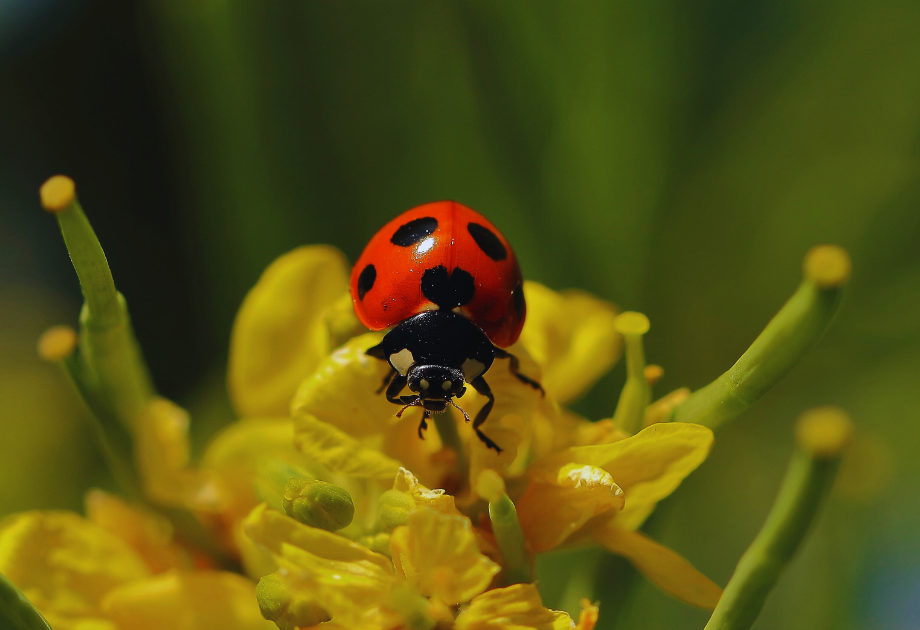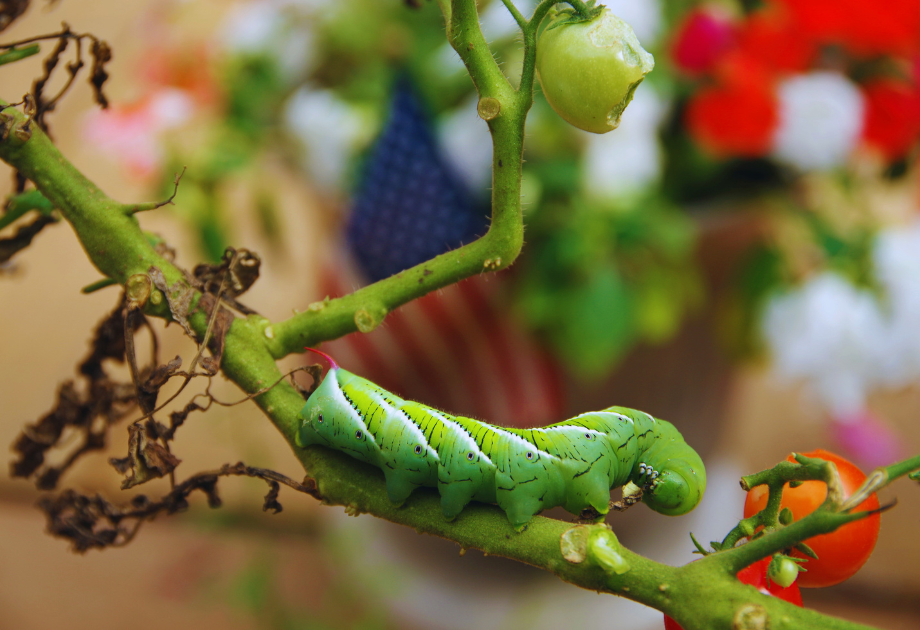Garden Bugs: The Good, the Bad, and the Bugly
Garden Bugs: The Good, the Bad, and the Bugly
.png)
It's finally summer, and gardens in the Miami Valley are once again full of life. Bees hover over blooms, beetles dive beneath leaves, and the soil never stays still for long. Some of those visitors are helping your garden thrive... Others are treating it like an all-you-can-eat buffet.
This blog offers a gardener’s guide to spotting the difference. You’ll learn how to recognize helpful insects, catch pest problems early, and build a garden that keeps the right bugs coming back.

Meet the Good Bugs: Your Garden Allies
Beneficial insects support your garden in three major ways: pollination, pest control, and soil health. While honeybees tend to get the spotlight, they’re just one part of the crew. Ladybugs, lacewings, ground beetles, hoverflies, parasitic wasps, and even spiders contribute in ways that keep the garden balanced.
Ladybugs, for instance, are well-known aphid assassins, especially in their larval stage when they look more like little alligators than beetles. Lacewings, with their delicate wings and golden eyes, aren’t just pretty—they’re predators in disguise. Hoverflies look like tiny wasps but act more like drones with a mission, pollinating as they dart between flowers.
Some of the hardest workers stay hidden. Ground beetles roam at night, feeding on slugs and cutworms. Parasitic wasps lay their eggs in or on pests like tomato hornworms, helping to reduce damage without you lifting a finger. Even the creepy-crawlies under your mulch may be aerating soil and breaking down organic matter, improving your garden’s foundation.
How to Attract Beneficial Bugs to Your Garden
If you want more beneficial garden insects, start by planting with them in mind. Incorporating plants that repel bugs alongside nectar-rich flowers gives helpful insects food and shelter while making life harder for the troublemakers. Let a few herbs like dill, fennel, and parsley go to flower; they’ll attract ladybugs, especially in their larval stage when they’re hungriest. Garlic and chives, on the other hand, can help keep aphids away. Once you’ve got the menu planned, it’s time to think about where your beneficial bugs will make themselves at home.
Avoid over-mulching or over-tidying. Many helpful insects need tucked-away places to lay eggs or rest during the day. Tunnel-nesting bees may move into hollow stems, while ground-nesting bees prefer undisturbed soil. Include shallow water dishes with stones for landing, and leave a few wild spots or pollinator strips to encourage biodiversity.

Meet the Bad Bugs: Who’s Munching on Your Plants
Even the most carefully planned gardens can draw in unwanted guests. The trick is knowing who they are by what they leave behind. Chewed leaves with black specks often point to flea beetles. Foamy blobs tucked into stems usually mean spittlebugs. Slime trails? You’re looking at slug activity.
Garden bugs like aphids, squash bugs, cucumber beetles, cutworms, hornworms, and grasshoppers are common summer culprits in USDA Zone 6. Aphids reproduce rapidly and cluster underneath leaves, leaving behind sticky residue called honeydew. Squash bugs lay copper-colored eggs on the underside of leaves and feed by piercing plant tissue, often causing wilting or collapse.
Tomato hornworms are heavy feeders and can strip a tomato plant in a single night. Their green coloring makes them easy to miss until the damage is already done. Cutworms go after young seedlings at the base, severing stems close to the ground. And grasshoppers tend to show up during dry spells, munching on just about anything that’s still green.
Signs of Trouble: How to Know It’s Time to Intervene
Some damage is part of the gardening experience. But when a few holes become whole missing leaves, it’s time to act. Watch for early warning signs like wilting, curling, speckled leaves, or a sticky coating that wasn’t there the day before. Discoloration, black sooty mold, and clusters of bugs gathered in corners or undersides are clues that something is off.
Catching a pest early means you have more options. You can introduce or protect natural predators, apply targeted remedies, or remove the problem by hand. A little damage might be tolerable, but fast-moving pests like aphids and hornworms can take over quickly if left unchecked. Spotting issues early helps you stay ahead without having to resort to chemical sprays.
.png)
Garden Bug Management: Natural Remedies That Work
The best natural pest control methods are the ones that support your whole garden, not just one plant. Think of it as building a system that discourages pests without disrupting the rest of your ecosystem.
Start with physical solutions. Hand-picking is still one of the most effective ways to deal with pests like hornworms and slugs, especially when numbers are low. For grasshoppers, try a shallow container filled with a 10% molasses and water mixture—it draws them in and keeps them there. Row covers help protect young crops by creating a physical barrier, without cutting off airflow or sunlight.
If you’re considering treatments, choose them carefully. Diatomaceous earth, a natural powder made from fossilized algae, works by drying out insects that come into contact with it. But it kills indiscriminately, including beneficial bugs, so apply it sparingly and only in targeted areas. Always use it on dry soil and reapply after rain.
Cold-pressed neem oil interferes with pest feeding and reproduction, but timing is everything. Apply early in the morning or late in the evening to reduce the risk to pollinators. And make sure the product is truly cold-pressed and free from additives that could cause unintended harm.
Then there are your living strategies. Companion planting can reduce pests naturally while supporting garden health. Basil helps repel flies and thrips. Marigolds deter nematodes. Nasturtiums attract aphids away from more vulnerable plants. Trap crops follow the same logic—grow something the pests prefer nearby to protect your main harvest.
Skip the vinegar. It’s often mentioned as a natural bug deterrent for plants, but higher concentrations can damage leaves and flowers. Instead, build your garden’s resilience by observing what’s working and making small, steady adjustments over time.
Need help choosing the right approach? Our team is always ready with expert tips and gardener-tested products—just stop by.

Create a Balanced Ecosystem: Invite the Right Bugs to Stay
Instead of thinking about how to get rid of bugs in your garden, focus on how to attract the right ones. A garden that supports beneficial bugs tends to have fewer pest problems in the long run. Biodiversity adds resilience. Different insects fill different roles, and together, they help maintain a healthy balance.
Try rotating crops each year to discourage pest buildup. Mix herbs with vegetables, interplant flowers like calendula or yarrow, and let some of your “weeds” bloom—plants like dandelion or Queen Anne’s lace can support early-season pollinators. Small wild areas or pollinator strips offer refuge, food, and egg-laying spaces.
Native bees, which pollinate many of our fruits and vegetables, often nest in the ground or in small tunnels. Avoid disturbing all of your soil at once. Try to cultivate only a portion at a time to preserve habitat.
Fewer than 1% of insects are considered harmful. Most are neutral or helpful. That means a thriving garden isn’t bug-free—it’s bug-smart.
Make Your Garden Bug-Smart with Knollwood Garden Center
Understanding the bugs in your garden turns frustration into confidence. You don’t always need harsh sprays to protect your plants—just knowledge, patience, and the right tools. At Knollwood Garden Center, we offer more than advice. You’ll find pollinator-friendly plants, expert guidance on plants that repel bugs, and natural products that support a healthy garden ecosystem.
Need help identifying a mystery bug or finding a solution that fits your space? Our team is here for that. Visit us in-store or reach out through our contact page.
Healthy gardens start with smart choices—and we’re here to help you make them.
